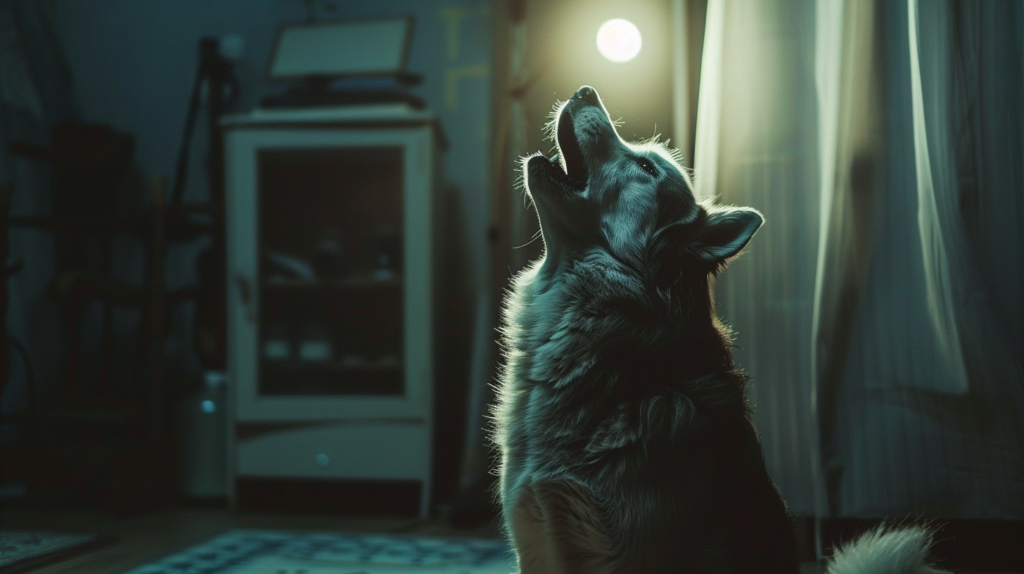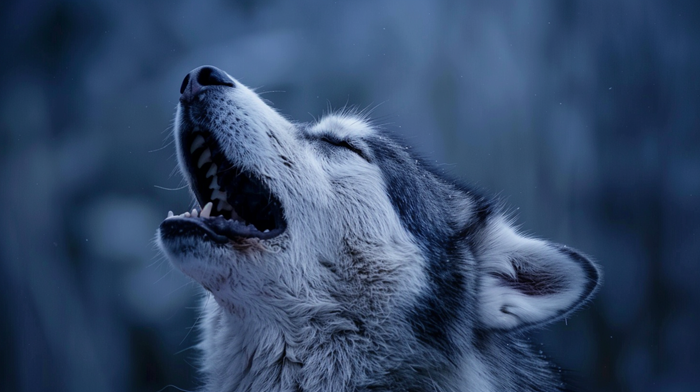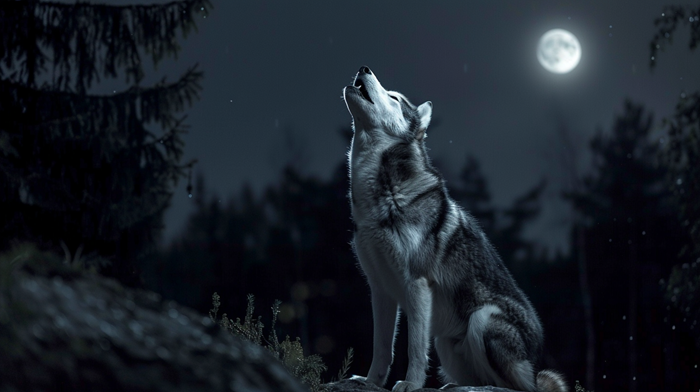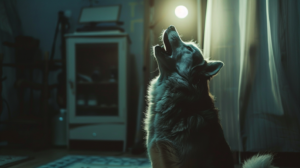
Lying awake to the sound of my dog howling into the night, I couldn’t resist diving into research to understand this behavior. It turns out that this isn’t just a random act. Their history and evolution are deeply rooted in it, returning to their ancestral calls and adapting to modern urban challenges.
Bustling city noises and internal factors like illness trigger their response, which creates a complex web of reasons behind each howl. Even their diet and dreams might influence it. This knowledge has transformed my perception of their howling from mere noise to a form of communication. Understanding why they behave this way at night fascinatingly connects us with a part of their ancient past.
Why do dogs howl at night? They could be…
1. Sensing danger
2. Signaling illness or injury
3. Responding to other dogs
4. Responding to high-pitched sounds
5. Expressing loneliness or fear
6. Expressing excitement or happiness
7. Asking for food
8. Asking to go potty
9. Dreaming
It’s time to understand what your dog is trying to say when they howl. Your dog could be…
1. Sensing Danger
Dogs have an exceptional sense of hearing that surpasses human capabilities. This enables them to pick up on sounds and frequencies we cannot. Their sharp hearing alerts them to strangers or unusual activities around their home, often before their owners notice anything.
Trained as protectors, guard dogs bark or howl as a primary response to alert their family. While howling serves more as an ancestral call or expression of unease, it is integral to their role in signaling potential threats.
Our dogs’ protective responses are triggered by detecting unfamiliar cues, like distinct sounds or scents, showcasing their comprehensive protective and communicative behaviors.
2. Signaling Illness or Injury
When dogs howl more than usual, particularly if they’re typically quiet, it may signal underlying health issues. This increased vocalization can be a dog’s method of expressing pain or discomfort that isn’t immediately apparent to their owners.
Several health conditions could trigger this behavior, with arthritis being a common culprit. Arthritis leads to chronic pain, making dogs more vocal as they attempt to communicate their suffering. Similarly, internal injuries, which are not visible on the surface, can cause a dog to howl due to the pain they experience.
Pet owners need to pay close attention to such changes in their dog’s behavior, alongside other symptoms of distress, and seek veterinary advice promptly to address any potential health problems.
3. Responding to Other Dogs
Howling among dogs isn’t just a throwback to their wild ancestors; it’s a vibrant part of their social toolkit today. Originating from wolves, who use howls to communicate over long distances or rally the group, domestic dogs retain this instinct.
When one starts howling, it often triggers others to join, creating a network of communication that transcends physical boundaries. This behavior showcases not only their ability to signal location but also their desire for social connectivity, reinforcing the pack dynamics ingrained in their DNA.
4. Responding to High Pitched Sounds
The intriguing response dogs show to sirens and musical instruments highlights their sensitive hearing and instinctual roots. Unlike responding to other dogs, this reaction may stem from an innate curiosity or confusion, as these sounds could mimic the vocal range or pitches found in natural dog howlings.
This auditory stimulus provokes a blend of ancestral call-and-response behavior, suggesting a deep-seated recognition or an alert mechanism. Through such responses, dogs demonstrate their connection to their environmental and ancestral heritage, blending past instincts with present experiences.

5. Expressing Loneliness or Fear
Dogs are inherently social creatures. They express loneliness or fear through howling, which becomes more pronounced in the stillness of the night. This act serves dual purposes: attracting attention and signaling discomfort. Such behavior is widespread among dogs left to sleep alone, underscoring their need for company.
Certain breeds, notably Huskies and Beagles, are more inclined to howl due to their ancestral lineage linked to wolves. This tendency does not merely reflect a habit but indicates a feeling of loneliness or fear of being separated from their owners.
For a deeper understanding of this behavior, the Royal Veterinary and Agricultural University in Copenhagen has conducted studies that shed light on the nocturnal behaviors of domestic dogs, offering valuable insights into how to better cater to our canine companions’ emotional needs.
6. Expressing Excitement or Happiness
Nocturnal cries from our furry friends may often seem like signals of distress or claims to their territory. However, these sounds can also signify excitement or joy despite resembling sobs. For instance, a dog might howl in response to a familiar car pulling into the driveway or a family member’s voice.
This form of vocalization allows dogs to express their joy and anticipation of positive interactions. It’s essential to observe the context of the howling, as the same behavior could have different meanings depending on the situation. Recognizing these nuances aids in understanding our canine companions better.
7. Asking for Food
When your dog makes those nighttime sounds, it’s often because they’re hungry. They’re saying, “Hey, I need food!” That’s why feeding them right and on time is essential. Giving them enough food throughout the day can reduce those calls for snacks. They’re trying to tell us they need something, and food is often the answer.
8. Asking to Go Potty
Your puppy might be signaling more than just a desire for attention. They could be indicating a need to relieve themselves. Young dogs have less bladder and bowel control, making immediate needs more urgent. Vocal cues become their way of communicating this discomfort.
As pet owners, it is crucial to recognize these signals as potential bathroom alerts. This understanding helps us respond to their needs on time. Early on, puppies learn that vocalizing can lead to being let outside, reinforcing this method of communication.
9. Dreaming
Dogs experience a range of emotions in their dreams. When dogs howl in their sleep, it often reflects what they’re dreaming about. These vocalizations could be tied to their instincts. Dreaming allows dogs to process their daily experiences and consolidate memories.
Howling can indicate that they’re engaging with scenarios in their dream world that invoke their natural behaviors. This phenomenon shows the depth of canine dreams and how closely their sleeping patterns mirror their waking life and instincts.
The Secrets to Controlling Your Dog’s Noise at Night
Scientists have been busy finding out how to reduce stress and noise among shelter dogs. Here are the cool tricks they discovered, as detailed in a study by the University of Southampton’s Department of Psychology.
- Treats for Silence: Just like getting a cookie for staying quiet, giving dogs treats when they stop barking works! This simple method significantly reduced barking, making the shelter quieter.
- Classical Music Over Audiobooks: While both sounds were tested to see if they could soothe dogs missing their humans, classical music emerged as the winner. Dogs relaxed more quickly with music than spoken words, although sounds alone didn’t significantly affect the overall stress level.
- Soothing Scents: Experimenting with smells such as vanilla or coconut showed promising results. Certain scents made the dogs quieter and even encouraged them to sleep, proving that dogs’ moods can be influenced by what they smell.
- Extra Play or Chill Time: Giving dogs more time to play or hang out calmly improved their behavior. Although some old habits returned once they were back in their kennels, there was a noticeable decrease in barking and jumping around.
These innovative approaches show that reducing your dog’s stress and noise is possible.

The Moon’s Influence?
The belief that the full moon influences dog howling is widespread among pet owners. Comprehensive studies have yet to conclusively link the lunar cycle with significant changes in canine behavior. This suggests that while environmental factors associated with the full moon, such as increased brightness at night, might affect some dogs, attributing changes in behavior solely to the moon’s phases could be misleading.
Moreover, the idea that dogs howl more during a full moon because of their ancestral connection to wolves is a romantic notion not backed by solid evidence. In reality, dogs’ howling is a form of communication often triggered by specific stimuli rather than the lunar cycle. It’s crucial to differentiate between anecdotal observations and scientifically verified data to accurately understand our pets’ behaviors.
Foretelling a Loved One’s Death
The belief that a dog howling at night foretells death is steeped in folklore rather than fact. As stated above, dogs may howl for various reasons. These behaviors are natural communication methods for dogs and do not possess mystical insights into future events.
Modern interpretations of a dog howling align more with understanding their needs or health issues rather than predicting mortality. It’s essential to observe the context in which a dog howls; often, it’s a sign they’re seeking attention or expressing discomfort rather than signaling an impending death.
Breed-Specific Tendencies to Howl
Some dog breeds are more likely to howl because of their genetics and historical roles.
Breeds such as Beagles, Bloodhounds, and American Foxhounds often use howling to communicate over distances or signal their location during hunts.
Ancient breeds such as Alaskan Malamutes and Siberian Huskies are closely related to wolves. They naturally howl to communicate with each other, an instinct stemming from their pack-living ancestors.
This trait is not just a remnant of their wild ancestors but serves practical purposes in their domesticated environments. It facilitates communication with their human families and responding to stimuli.
Understanding these breed-specific tendencies towards howling can enhance our approach to training and living harmoniously with these vocal canines.
Sources:






